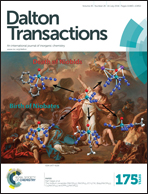Topoisomerase IIα poisoning and DNA double-strand breaking by chiral ruthenium(ii) complexes containing 2-furanyl-imidazo[4,5-f][1,10]phenanthroline derivatives
Abstract
Four chiral Ru(II) complexes bearing furan ligands, Δ/Λ-[Ru(bpy)2(pocl)]2+ (Δ/Λ-1) and Δ/Λ-[Ru(bpy)2(poi)]2+ (Δ/Λ-2) (bpy = 2,2′-bipyridine, pocl = 2-(5-chlorofuran-2-yl)imidazo[4,5-f][1,10]phenanthroline, poi = 2-(5-5-iodofuran-2-yl)imidazo[4,5-f][1,10]phenanthroline), were synthesized and characterized. These Ru(II) complexes showed antitumor activities against HeLa, A549, HepG2, HL-60 and K562 tumor cell lines, especially the HL-60 tumor cell line. Moreover, Δ-2 was more active than other complexes accounting for the different cellular uptakes. In addition, Δ-2 could accumulate in the nucleus of HL-60 cells, suggesting that nucleic acids were the cellular target of Δ-2. Topoisomerase inhibition tests in vitro and in living cells confirmed that the four complexes acted as efficient topoisomerase IIα poisons, DNA double-strand breaks had also been observed from neutral single cell gel electrophoresis (comet assay). Δ-2 inhibited the growth of HL-60 cells through the induction of apoptotic cell death, as evidenced by the Alexa Fluor® 488 annexin V staining assays. The results demonstrated that Δ-2 acted as a topoisomerase IIα poison and caused DNA double-strand damage that could lead to apoptosis.
![Graphical abstract: Topoisomerase IIα poisoning and DNA double-strand breaking by chiral ruthenium(ii) complexes containing 2-furanyl-imidazo[4,5-f][1,10]phenanthroline derivatives](/en/Image/Get?imageInfo.ImageType=GA&imageInfo.ImageIdentifier.ManuscriptID=C6DT01422D&imageInfo.ImageIdentifier.Year=2016)

 Please wait while we load your content...
Please wait while we load your content...